NRAO eNews
Volume 7, Issue 8
17 July 2014
NRAO eNews
Volume 7, Issue 8 • 17 July 2014

Upcoming Events

Transformational Science in the ALMA Era: Multi-Wavelength Studies of Galaxy Evolution
Aug 04 - 07, 2014 | Charlottesville, VA

MegaSAGE 2014 Surveying the Agents of Galaxy Evolution
Sep 02 - 05, 2014 | Charlottesville, VA

Filamentary Structure in Molecular Clouds
Oct 10 - 11, 2014 | Charlottesville, VA

4th VLA Data Reduction Workshop
Oct 27 - 31, 2014 | Soccoro, NM

Revolution in Astronomy with ALMA - The Third Year
Dec 08 - 11, 2014 | Tokyo, Japan
High Frequency, High Resolution ALMA Observations as a Probe for AGN Activity in Arp 220
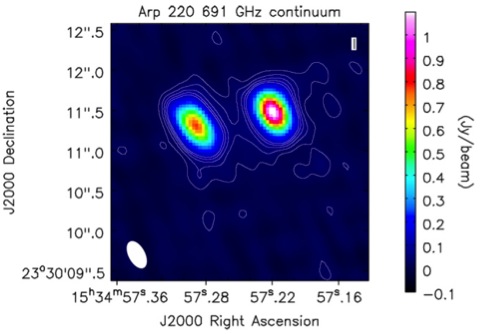
[click to enlarge]
Christine Wilson (McMaster) and her collaborators have made use of new ALMA high-resolution (~ 0.3") 691 GHz continuum observations of the galaxy merger Arp 220 to address the starburst/AGN nature of its embedded nuclei (2014 ApJL 789, 36). Arp 220 is the nearest of a class of ultra-luminous infrared galaxies which have infrared luminosities LIR[8-1000 μm] ≥ 1012 L(sun) that rival the bolometric luminosities of quasi-stellar objects (QSOs). The two nuclei are observed to be the dominant components of the 691 GHz emission (See Figure).
The authors use the deconvolved sizes of the nuclei to estimate their brightness temperatures, then to ultimately estimate their thermal dust temperatures and optical depths. Both nuclei together are estimated from the dust temperatures and disk extents to account for most or all of the infrared luminosity of Arp 220. The western nucleus is shown to have a very high dust temperature (~200K) and to be optically thick, with τ(434μm) = 5.3. Its derived luminosity surface density of ~1014 L(sun)/kpc2 exceeds the dust Eddington limit in which radiation pressure on dust grains in optically thick environments is the dominant feedback against the disk's self-gravity. While this evidence tentatively points to the western nucleus being host to a luminous AGN, similarly derived properties for the eastern nucleus are well within the range of starbursts-only models. The authors conclude by stating that future ALMA observations of Arp 220 with longer baselines will allow the luminosity surface density to be better constrained, and thus the assessment of the presence of a luminous AGN to be more definitive.
2014 Jansky Lecturer
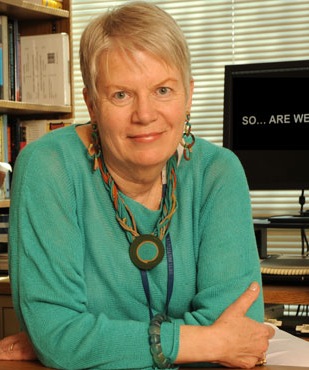
SETI.org
Dr. Jill Tarter
I am pleased to announce that Dr. Jill Tarter has been selected to present the 49th annual Jansky Lecture. Dr. Tarter has been central to the Search for Extraterrestrial Intelligence (SETI). She is the Bernard Oliver Chair for SETI at the SETI Institute in Mountain View, California, and is the former Director of the Center for SETI Research. Tarter is being honored for her role in pioneering methods for searching for extraterrestrial intelligence using radio techniques, as well as her leadership in the emerging field of astrobiology.
Tarter received a Bachelor of Engineering Physics with Distinction from Cornell and went on to receive her Masters and Ph.D. degrees in Astronomy from the University of California at Berkeley. She is credited with coining the term “brown dwarf” to refer to substellar objects that fail to achieve hydrogen burning in their cores. She served as Project Scientist for NASA’s SETI program, the High Resolution Microwave Survey. The SETI Institute was founded in 1984; Jill was one of its founding members and continues to serve as a trustee. Following the termination of funding for NASA’s SETI program in 1993, she served in a leadership role to secure private funding to continue the search, serving as Director of Project Phoenix under the auspices of the SETI Institute.
Jill has received numerous awards in recognition of her achievements: to name a few, she received a Lifetime Achievement Award by Women in Aerospace in 1989, was named a Fellow of the American Association for the Advancement of Science in 2002 and a Fellow of the California Academy of Sciences in 2003; she received the Adler Planetarium Women in Space Science Award in 2003; and was named one of the 100 most influential people in the world by Time Magazine in 2004.
Tarter is deeply involved in the education of future citizens and scientists. In addition to her scientific leadership at NASA and the SETI Institute, she has been the Principal Investigator for two curriculum development projects funded by NSF, NASA, and others: the Life in the Universe series of science teaching guides for grades 3-9, and Voyages Through Time, an integrated high school science curriculum on the fundamental theme of evolution. Jill is a frequent speaker at science teacher meetings and museums/science centers, bringing her commitment to science and education to both teachers and the public.
We look forward to welcoming Dr. Tarter to NRAO as the 2014 Jansky Lecturer.
ALMA Program Status
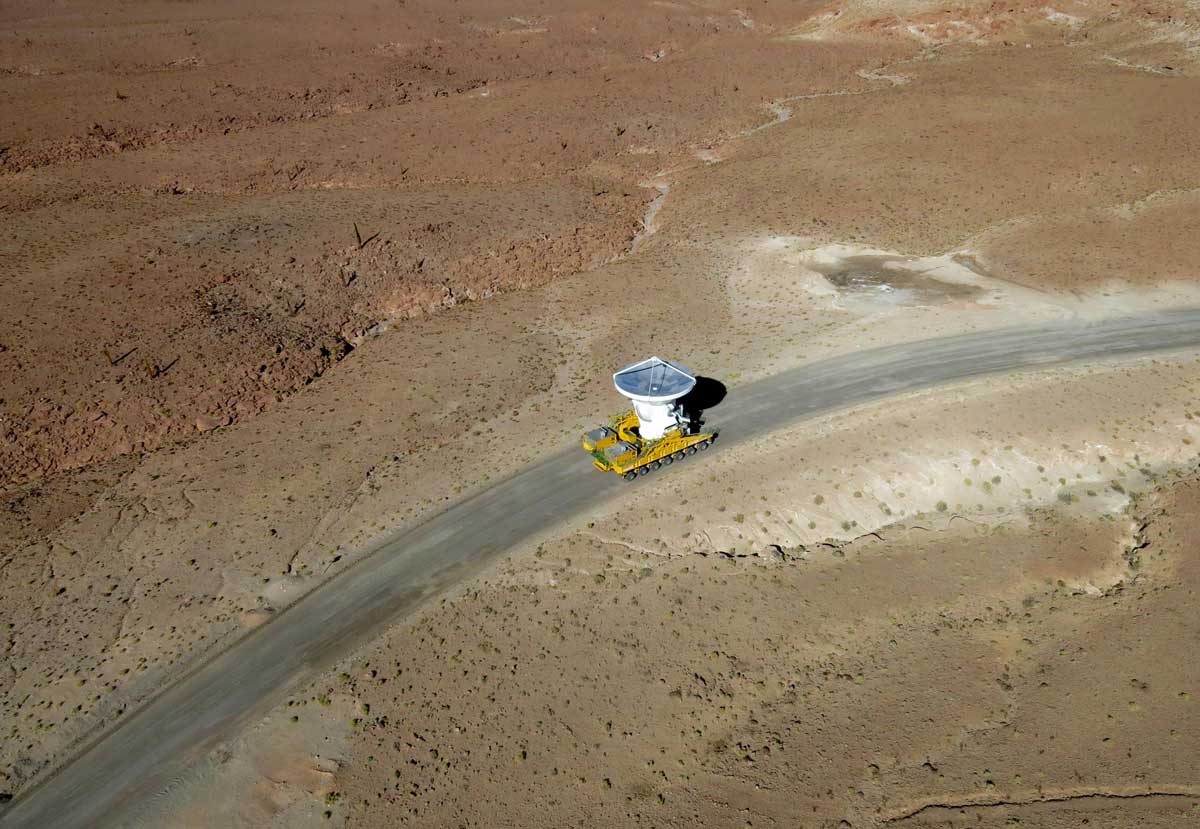
Ariel Marinkovic / X-Cam; ALMA (ESO/NAOJ/NRAO)
The final ALMA antenna makes its way to the Array Operations Site (AOS) in Chile.
[click to enlarge]
Cycle 2 of ALMA Early Science began on schedule on 1 June, with science observations commencing 3 June. This Cycle will extend until October 2015. The array is now observing the fifth weeklong block of projects. A detailed report on the outcome of the ALMA Early Science Cycle 2 Proposal Review Process is available. The report details the proposal review process, proposal statistics, and regional distributions as well as the proposal distribution across science categories and receiver bands. Cycle 2 proposal abstracts for A and B graded projects are also now available in the ALMA Science Portal.
Cycle 2 A and B graded projects were eligible for Student Observing Support awards. Demand was high, with about 40 proposals submitted. An external committee met to rank the proposals. Although the demand exceeded the available funding, 15 proposals will be granted partial funding. Award letters will soon be sent to the successful proposers.
The array is in a higher resolution configuration, with a longest baseline of 650m, and is planned to cycle into larger configurations as the austral winter progresses. For information on the execution of an accepted project, PIs and Co-Investigators can consult the Project Tracker. Starting with this cycle, PIs and PI-delegated investigators can modify their user profile at the Science Portal to receive e-mail notifications whenever a component of a project is first observed, fully observed, or successfully processed. In addition, an on-line interface to the ALMA calibrator source catalogue is now available at the Science Portal. See the March 2014 edition of The Messenger for a description of the ALMA calibrator survey, which is accessible online.
All Cycle 0 Early Science data has been delivered. As one-year proprietary periods end, the data is made available via the ALMA archive. Thirty-one papers have been published on data from 23 of the 37 datasets delivered to North American PIs (excluding fillers). The first Cycle 1 data have appeared in the literature and in the ALMA archive report on the completion of Cycle 1 and start of Cycle 2. Twenty-five of 69 North American high priority Cycle 1 projects have now been fully delivered and some data has been delivered for 53 projects. As recently announced, uncompleted Cycle 1 Early Science projects with high priority will continue to be observed into Cycle 2.
Proposers of approved Target of Opportunity (ToO) projects are now able to submit triggers via a dedicated form at the ALMA Science Portal for observations that fulfill the selection criteria specified in their proposal. Proposals for Director Discretionary Time (DDT) to be performed with Cycle 2 capabilities can also be submitted. During June, one new Cycle 2 DDT project was received and reviewed.
Transitions
ALMA Program Manager Masao Saito left ALMA on 30 June to assume his new position as Director of Nobeyama Radio Observatory beginning 1 July. We appreciate the work he has done leading the Program Management Group at the Joint ALMA Observatory in Chile. ALMA Deputy Program Manager Andreas Lundgren also left ALMA and has returned to Sweden. He set up observing procedures and led ALMA observations from Cycle 0. The success of ALMA observations to date owes much to his work in the Program Management Group. Daniel Espada has accepted the position as Deputy Program Manager starting 14 July. Plans for the Program Manager position are in progress; meanwhile L-A. Nyman, Head of Science Operations is in charge of the Program Management Group.
4th VLA Data Reduction Workshop

Registration is open for the 4th VLA Data Reduction Workshop which will take place 27 - 31 October 2014 at the NRAO New Mexico Array Science Center (NMASC), in Socorro. The aim of the workshop is to assist observers with the data reduction challenges posed by the increased flexibility and complexity of the VLA.
During this workshop observers will be able to reduce their own VLA data using hardware provided by NRAO and with NRAO staff experts present for consultation. There will also be presentations by local staff covering CASA and the very latest developments in data reduction techniques.
This is an advanced workshop, and unlike our summer Synthesis Imaging Workshops, is not intended for those who are new to radio interferometry. Prior experience with AIPS, CASA, or MIRIAD is required. As we will be using CASA as our main data reduction package, a working knowledge of it would be helpful: we strongly recommend those new to CASA go through one or more of our tutorials prior to attending the workshop.
As we have 30 workstations available, we must limit the number of participants to around 30. In a limited number of cases, two participants working on the same data may share a machine; this can be requested during registration. To register please go to the Workshop website, the contents of which will be further updated as we get closer to the actual workshop dates.
We look forward to welcoming you to Socorro!
7th MegaSAGE Meeting

2-5 September 2014
Charlottesville, Virginia
The MegaSAGE – Surveying the Agents of Galaxy Evolution – consortium studies the life cycle of matter that drives the evolution of galaxies, focusing on the Magellanic system and the detailed interplay of gas, dust, newly forming and evolved dying stars. This study has included surveys with Spitzer and Herschel, and detailed ongoing studies with other instruments. Currently ALMA is revolutionizing our understanding of dense gas in the Universe, and is a primary focus for our Magellanic studies.
The 7th annual project meeting will be held at the NRAO Headquarters in Charlottesville, Virginia, from 2-5 September 2014 and will feature discussions of ongoing projects as well as future proposal planning and discussion. There will be four full days of meetings, as well as a conference dinner.
Please visit the meeting website for additional information and contact Remy Indebetouw if you have any questions.
Filamentary Structure in Molecular Clouds
10-11 October 2014
Charlottesville, Virginia
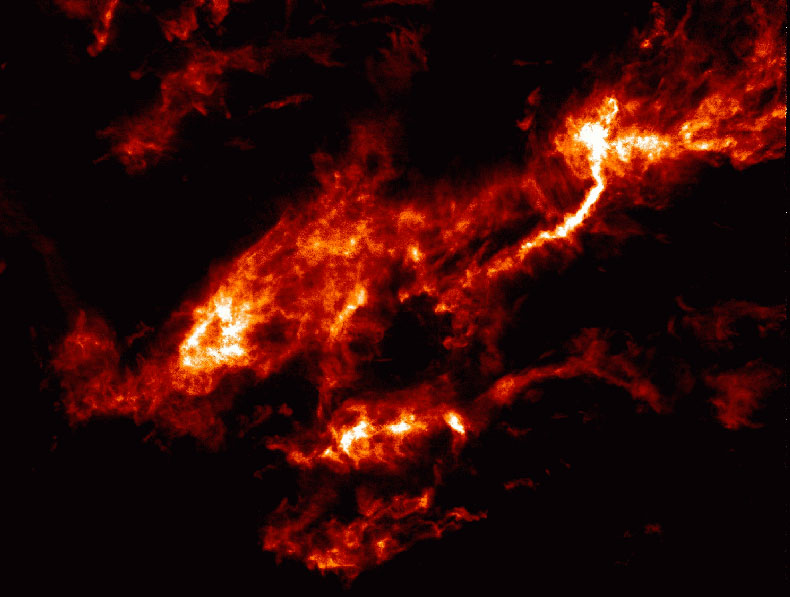
Narayanan et al. 2008, ApJSS, 117, 1, 341
[click to enlarge]
Workshop Scientific Goals
Filamentary structure in clouds has been observed dating back many years. In addition, numerical hydrodynamic and MHD simulations of clouds over the past ~15 years have consistently shown that filamentary structure is always present, and may be produced by turbulence and self-gravity. Recent Herschel observations of nearby dust clouds have highlighted that the dense gas is distributed predominantly in filaments. Filamentary structure may be ubiquitous in the internal structure of all molecular clouds and may be preferential formation sites of the dense cores that eventually collapse to form stars.
If such filamentary structures were universal in all molecular clouds with low and high mass star formation, then the entire paradigm of cloud formation and evolution leading to star formation would be placed on a framework that centers on cloud condensation into filaments and filament fragmentation into cores. Filaments and embedded cores may also develop simultaneously, as suggested by some numerical simulations. It will be important for observational studies of star formation in molecular clouds to delineate the conditions, including magnetic fields, and the time sequence for the formation and evolution of dense filaments and cores within them.
This two-day science workshop will be held at NRAO Headquarters in Charlottesville, Virginia on 10-11 October 2014 and will discuss the current evidence for the picture described above and will formulate future observational and theoretical investigations to verify whether such filamentary structure is universal and to study the physical conditions and evolution of such structures.
Workshop Format
The workshop aims to stimulate discussions of outstanding issues and future studies. A few short review talks (30 minutes total, including 5 minutes for Q&A) will set the stage, but contributed papers are encouraged. The Scientific Organizing Committee (SOC) will select some papers for contributed talks (10 minutes plus 5 minutes for Q&A) and will select others as posters that will be displayed throughout the meeting. Ample time will be set aside for panel-audience discussions, as well as for coffee breaks and lunches to allow viewing and discussion of posters.
Please visit the workshop website for additional information or contact the SOC Chair if you have questions.
The key workshop dates and deadlines are summarized below.
Key Workshop Dates and Deadlines
| Preregistration Opens | 19 Jun 2014 |
| Call for Abstract Titles | 19 Jun |
| Registration Opens | 18 Jun |
| Abstract Due | 1 Aug |
| Final Scientific Program | 15 Aug |
| Hotel Reservation Deadlines | 9 Sep (Red Roof), 18 Sep (Marriott) |
| Registration Closes | 19 Sep |
14th Synthesis Imaging Workshop
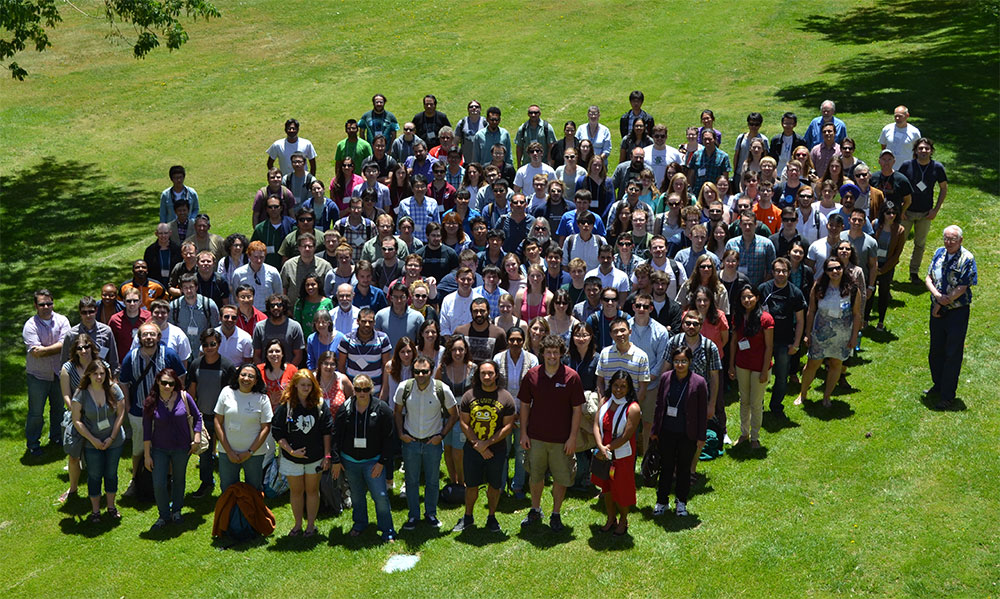
[click to enlarge]
The 14th Synthesis Imaging Workshop was held 13-20 May 2014 in Socorro, NM. Most of the workshop was held at Workman Center on the campus of the New Mexico Institute of Mining and Technology (NMT). The data reduction tutorials were partially held at NRAO's Domenici Science Operations Center in Socorro. There were four days of lectures, two days of data reduction tutorials, and one afternoon of observation preparation tutorials. Other events included a reception, workshop dinner, hikes of the Magdalena Mountains and the Bosque del Apache, and a very popular tour of the Jansky Very Large Array (VLA).
There were 152 registered participants from 20 countries. Over half the participants were graduate students; scientific and engineering staff, postdocs, undergraduates, and faculty also attended.
The students spent one afternoon learning the important considerations for observing and how to prepare for VLA and ALMA observations. There were also two full days of data reduction tutorials. Participants could choose tutorials using VLA, VLBA, LWA and/or ALMA data. The datasets and a guide to reducing them in CASA are online.
Fifteen of the 25 lecturers were from NRAO. The other lecturers were from Naval Research Lab, the Netherlands's ASTRON, Harvard-Smithsonian Center for Astrophysics, New Mexico Tech, University of New Mexico, and the Square Kilometer Array. We thank all the lecturers for giving their time and talents to the workshop.
The 2014 Synthesis Imaging Workshop presentations (pdf format) and lectures (video) are available online.
We thank NRAO and AUI for providing logistical and financial support and a majority of the lecturers. We are grateful to New Mexico Tech for providing the use of their facilities, and particularly the support of the Physics Department. We also thank the University of New Mexico and the Institute of Geophysics, Planetary Physics at Los Alamos National Laboratory for financial support.
AIPSLetter and AIPS Memo Published
The semi-annual issue of the AIPSLetter has been published by the Astronomical Image Processing System (AIPS) group. It details changes in the 31DEC14 AIPS release in the first half of its development period. In addition, AIPS Memo 118 entitled Modeling Spectral Cubes in AIPS by Eric W. Greisen has also appeared. It describes the new versions of the Gaussian fitting task XGAUS, plus new tasks ZEMAN, which fits weak Zeeman splitting, and RMFIT, which fits rotation-measure models to cubes of Q and U polarization. These and all previous AIPS publications are available from the AIPS web site.
Recent Media Releases
|
Science, Engineering & Technology Milestones |
|
|
Remarkable White Dwarf Star Possibly Coldest, Dimmest Ever Detected |
|
|
Final ALMA Antenna Arrives on the Chajnantor Plateau |
|
|
Gigantic Explosion Buried in Dust |
|
|
ALMA Upgrade to Supercharge Event Horizon Telescope |
|
|
A Violent, Complex Scene of Colliding Galaxy Clusters |
|
|
ALMA Launches Website for Children |
Career Opportunities
New Postings
Software Engineer II: The National Radio Astronomy Observatory is accepting applications for a Software Engineer II position. The position may be located in Socorro, NM or Charlottesville, VA. The Software Engineer will be a member of the Common Astronomy Software Applications (CASA) development team. The new team member will primarily be responsible for CASA builds, build support and release packaging. As part of these duties, the Software Engineer will participate in extending the current build system (currently based on Cmake) and the existing automated test system (currently based on Jenkins and Robot Framework).
Software Engineer II: The National Radio Astronomy Observatory in Charlottesville, VA is now accepting applications for a Software Engineer II position. The successful applicant will work with CASA (Common Astronomy Software Applications) developers, project scientists, and stakeholders to design and implement a comprehensive test program. Duties will include assuming responsibility for existing test systems, improvement of existing test, and evaluation of test coverage for new capabilities.
Software Engineer II: The National Radio Astronomy Observatory in Green Bank, West Virginia is now accepting applications for a Software Engineer II position. Using prescribed methods, researches, conducts or coordinates detailed phases of software engineering work as assigned. The candidate will perform work that involves conventional software engineering practices.
Software Engineer II: The National Radio Astronomy Observatory is now accepting applications for a Software Engineer II position. Collaboratively with other NRAO staff, evaluate, deploy, maintain, and write web applications for the North American ALMA Science Center (NAASC) user portal, and support the configuration and operation of the NRAO Science helpdesk. This will require leveraging of existing NRAO web services and content, development of ALMA (Atacama Large Millimeter Array) and NRAO web service prototypes, and new technologies.
Mechanical Engineer II: The National Radio Astronomy Observatory in Socorro, NM is now accepting applications for a Mechanical Engineer II position. The candidate will be responsible for the carrying out and assisting in engineering analysis, design, and general execution of a project or whole system. Responsibilities include recommendations, coordination and assisting in decisions on such aspects as design, procurement, manufacture, erection, test and some degree of initial operation.
From the Archives
Ellen Bouton

[click to enlarge]
About this month's photo: The season for site picnics has arrived. In this 2001 photo from Tucson's picnic at Fort Lowell Park, an ALMA Test Facility (ATF) group is in charge of the grill. [Left to Right] Ralph Snel, a visitor from Lund University in Sweden working at the ATF who lived on a farm in Sweden and had a knack for grilling; Jack Meadows; Andrea Vaccari; and Jeff Mangum. Thanks to Jeff Mangum for caption information.
July is the anniversary of the NRAO Newsletter. The first bi-monthly issue, edited by Barry Turner and printed on intense deep gold paper, was dated 1 July 1981. The early Newsletters were primarily text – the first photograph did not appear until 1 October 1982, and photographs were few and far between for the first 15 years or more. The gold paper, however, remained an eye-catching fixture for 81 issues. The first issue on glossy white paper with color photos was number 82, dated 1 January 2000, a new format for the 21st century. Publication on paper ceased with issue 115 in April 2008, and electronic-only publication began with volume 1, issue 1, June 2008.
From the Archives is an ongoing series illustrating NRAO and U.S. radio astronomy history via images selected from our collections of individuals' and institutional papers. If readers have images they believe would be of interest to the Archives, please contact Ellen Bouton, ebouton@nrao.edu.

